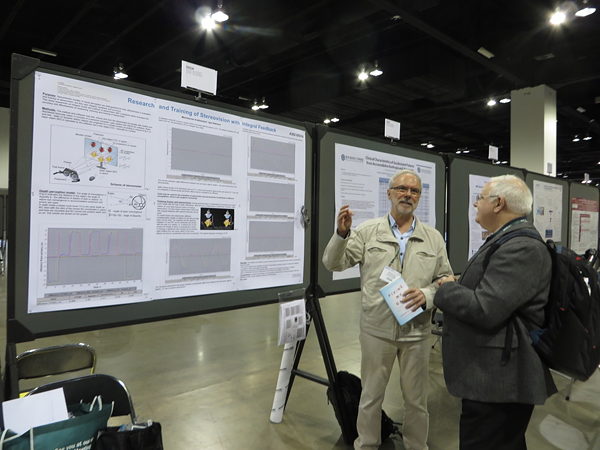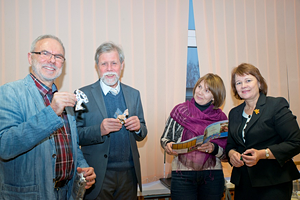| ~English |
| Главная | О нас | История | Аппарат АВИЗ-01 | Возможности метода |
| Принцип коррекции | Публикации | Результаты | Программы лечения | Схема проезда |
П у б л и к а ц и и |
Стереометр VISUS-4D признан на мировой конференции ARVO06 мая 2015 г. на ежегодной научной конференции крупнейшей и самой престижной организации оптометристов в мире - ARVO (на английском - The Association for Research in Vision and Ophthalmology - Ассоциация Исследований Зрения и Глаза) в Денвере, штат Колорадо, США, д.н. М. Врубляускас (Вильнюс, Литва) и проф. И. Рабичев (Москва, Россия) представили стендовый доклад «Исследование и тренировка стереозрения с обратной интегральной связью». Основой доклада является модель, метод и результаты исследования стереометра VISUS-4D. Стендовый доклад на английском языке представлен ниже инфо o конференции. Количество слов в докладе и фотографирование было строго ограничено. В представленной фото виден Harris Paul, один из оптометристов США, который корректировал методику тренировок стереозрения известного невро-ученного Susan R.Barry и редактировал её книгу «Fixing My Gaze». Susan R.Barry развила стереозрение в возрасте более 40 лет и является широко известной в TED (Technology, Entertainment, Design) учениях (http://www.youtube.com/watch?v=XCCtphdXhq8). 
Harris Paul, с Apple телефоном сфотографировал автора доклада д.н. М. Врубляускаса у стендового доклада с книгой Susan R.Barry в руке и фото отослал автору. На фото справа видно демо стереометра VISUS-4D для группы заинтересованных. Наибольший интерес был проявлен самому устройству, методике и результатам исследования стереометра VISUS-4D для людей с косоглазием и с отсутствием стереозрения. В группе из 15 человек 14 из них (93,3 проц.) разбудили стереозрение через несколько месяцев. На тренировках особенно важно ощущать движения обоих глаз и ощущения согласовать с движениями рук и окружающей средой. Поэтому для возбуждения и тренировки зрения обоими глазами, на экране стереометра VISUS-4D предъявляется не только базовый и тестовый объекты (см. презентацию ниже), но при необходимости, и дополнительные компоненты (например, круги) или маркер, размер которого пропорционален погрешности зрения. Это очень легко и четко позволяет понять, есть стереозрение или нет и соответственно корректировать как внимание, так и движения глаз и рук. Регистрация расстояния между тестовым и базовым объектами и при необходимости предъявление его на экране, образует обратную связь, что почти автоматизирует тестирование и обучение. Интегральность зрения образует согласование движений глаз и рук. 
Во время тренировок ощущения, движения и опыт накапливаются, корректируются и стереозрение развивается. Как в младенческие годы, потому что мозг является невропластичным и во взрослые годы. Исследования и тренировки стереометром и бинариметром проводит проф. И.Рабичев (Москва). На фото - д.н. М.Врубляускас и проф. И.Рабичев в гостях в Клайпедском Центре Развития Зрения (Литва) 01-12-2014 с директором Лайма Баранаускене (справа). Профессор замечает, что стереометр VISUS-4D является лучшим устройством для тренировки фузии и особенно стереозрения из того, что известно в России и на Западе. Это было видно и на выставке, состоявшейся во время ARVO. Презентацию в ARVO представил первый автор д.н. Мечисловас Врубляускас. Более обширно методика и результаты будут обсуждаться в других публикациях и конференциях. Ниже представлен стендовый доклад конференции на английском языке.
Research and Training of Stereovision with Integral Feedback Vrubliauskas Mečislovas1, 2; Rabichev Igor3, 4 Purpose: Sensorimotor models of visual perception are distinguished for their effectiveness in evaluation and training of stereovision, but they lack integrity, feedback and accuracy. This study researches an integral model and method of stereovision with a feedback which increases the accuracy and effectiveness of measuring, inducing and training of stereovision.
Methods: The method and software may test, induce and train the stereovision for people with healthy and disordered binocular vision. It consists of a personal computer, optic system and VISUS-4D software. Basic and test - static or dynamic stereo objects are projected on a monitor screen according to scheme (Fig.1). A basic object (BO) is operated by the software and a test object (TO) - manually by a testee.
Depth perception model. The angle of convergence α (Fig.2) indicates the distance to the object; the angle of disparity β - the difference of depths of dots or objects. To adjust eye convergence to accommodation polarizers and prisms are used. In static mode TO must be moved to the same depth as BO then by software or with the click of the mouse the coordinates in space and time are recorded and BO moved into another depth and so on. The results are shown on Fig.3. In dynamic mode BO moves in space further and closer with the period of 20 s. The distance between BO and eyes is 60 cm. All parameters can be changed very easily. The results are shown on Fig.4.
Static stereo-acuity of 35 individuals was up to 2' (~4 mm) and dynamic stereo-acuity was about 4'-6'. They had no complaint of stereo-acuity and those values may be considered as sufficient. Tests may be used for the evaluation of stereovision and stereoactivity of individuals of different occupations, drivers and surgeons inclusively.
Training fusion and stereovision. Having achieved fusion or eliminated the horizontal and vertical squint angle with the help of static and dynamic stereotests, often the lack of stereovision is determined. However, often neither do such tests improve fusion nor induce stereovision. For this reason stereometer VISUS-4D with integral feedback with special exercises can be used. To control fusion and stereovision different complementary details of objects for the left and right eyes can be used. The disparity and the distance between TO and BO can be assessed and shown with the help of a marker, i.e. a vertical line on the screen the length of which is proportional to them. In training a significant role is played by two factors: sight shifting from the closer object to the more distant one and its coordination with hand movements. The optimal disparity of training is 15'-6'. Some other results are shown on the graphs.
A trainee seeing the objects and sensing the movements of eyes and hands and if needed receiving references corrects the movements of his hand and eyes, and gradually accumulates and increases their stereo-acuity.
A result after a few minutes of exercises is more than twice (1.689/0.74=2.3) better. In the tested group the most of individuals who had no stereovision could it induce by training in a few months (14 out of 15 or 93.3%).
Results: The method and software may test, induce and train the stereovision with healthy and disordered binocular vision. Tests may be used for the evaluation of acuity of stereovision and stereo-activity of individuals of different occupations, drivers and surgeons inclusively. Static stereo-acuity up to 2' and dynamic stereo-acuity up to 4'-6' may be considered as sufficient. Most of individuals (93,3 proc.) who had no stereovision can it induce by training in a few months. Conclusions: Evaluation and training of characteristics of stereovision by using an integral model with feedback confirm its high integrity, precision and effectiveness.
* - 1. VISUS-4D Center, Vilnius, Lithuania. www.visus4d.eu
27/06/2015 |
~English |
| All materials and images on this web site is copyrighted by ooo '' ВОСПРИЯТИЕ '' © 2007 all rights reserved |